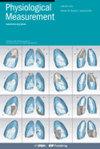LUNet: deep learning for the segmentation of arterioles and venules in high resolution fundus images
IF 2.3
4区 医学
Q3 BIOPHYSICS
引用次数: 0
Abstract
Objective. This study aims to automate the segmentation of retinal arterioles and venules (A/V) from digital fundus images (DFI), as changes in the spatial distribution of retinal microvasculature are indicative of cardiovascular diseases, positioning the eyes as windows to cardiovascular health. Approach. We utilized active learning to create a new DFI dataset with 240 crowd-sourced manual A/V segmentations performed by 15 medical students and reviewed by an ophthalmologist. We then developed LUNet, a novel deep learning architecture optimized for high-resolution A/V segmentation. The LUNet model features a double dilated convolutional block to widen the receptive field and reduce parameter count, alongside a high-resolution tail to refine segmentation details. A custom loss function was designed to prioritize the continuity of blood vessel segmentation. Main Results. LUNet significantly outperformed three benchmark A/V segmentation algorithms both on a local test set and on four external test sets that simulated variations in ethnicity, comorbidities and annotators. Significance. The release of the new datasets and the LUNet model (www.aimlab-technion.com/lirot-ai) provides a valuable resource for the advancement of retinal microvasculature analysis. The improvements in A/V segmentation accuracy highlight LUNet's potential as a robust tool for diagnosing and understanding cardiovascular diseases through retinal imaging.LUNet:深度学习用于分割高分辨率眼底图像中的动脉和静脉
研究目的本研究旨在自动分割数字眼底图像(DFI)中的视网膜动静脉(A/V),因为视网膜微血管空间分布的变化是心血管疾病的征兆,从而将眼睛定位为心血管健康的窗口。方法。我们利用主动学习创建了一个新的 DFI 数据集,其中包含由 15 名医科学生完成并经一名眼科医生审核的 240 个众包人工 A/V 分割结果。然后,我们开发了 LUNet,一种针对高分辨率 A/V 分割进行了优化的新型深度学习架构。LUNet 模型采用双扩张卷积块来扩大感受野并减少参数数量,同时采用高分辨率尾部来完善分割细节。设计了一个自定义损失函数,优先考虑血管分割的连续性。主要结果在本地测试集和模拟种族、合并症和注释者差异的四个外部测试集上,LUNet 的表现明显优于三种基准 A/V 分割算法。意义重大。新数据集和 LUNet 模型(www.aimlab-technion.com/lirot-ai)的发布为视网膜微血管分析的发展提供了宝贵的资源。A/V 分割准确性的提高凸显了 LUNet 作为通过视网膜成像诊断和了解心血管疾病的强大工具的潜力。
本文章由计算机程序翻译,如有差异,请以英文原文为准。
求助全文
约1分钟内获得全文
求助全文
来源期刊

Physiological measurement
生物-工程:生物医学
CiteScore
5.50
自引率
9.40%
发文量
124
审稿时长
3 months
期刊介绍:
Physiological Measurement publishes papers about the quantitative assessment and visualization of physiological function in clinical research and practice, with an emphasis on the development of new methods of measurement and their validation.
Papers are published on topics including:
applied physiology in illness and health
electrical bioimpedance, optical and acoustic measurement techniques
advanced methods of time series and other data analysis
biomedical and clinical engineering
in-patient and ambulatory monitoring
point-of-care technologies
novel clinical measurements of cardiovascular, neurological, and musculoskeletal systems.
measurements in molecular, cellular and organ physiology and electrophysiology
physiological modeling and simulation
novel biomedical sensors, instruments, devices and systems
measurement standards and guidelines.
 求助内容:
求助内容: 应助结果提醒方式:
应助结果提醒方式:


